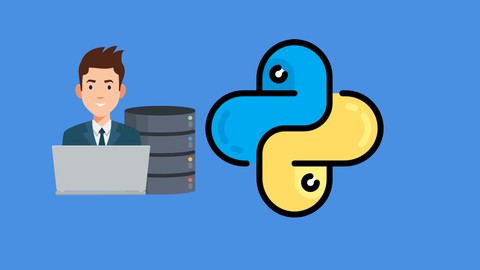
Python Django Engineer (REST APIs, PostgreSQL,GitHub,Heroku)
Python Django Engineer (REST APIs, PostgreSQL,GitHub,Heroku), available at $64.99, has an average rating of 4.25, with 213 lectures, based on 44 reviews, and has 9405 subscribers.
You will learn about Python Development Environment Setup Django Development Environment Setup Jupyter Notebook Server Setup Python Programming Fundamentals Python Object Oriented Programming Python Modules and Packages PostgreSQL Database Setup Git and GitHub Setup Build a Python Django Todo List Web App Build a Python Django Portfolio Web App Build a Python Django Image Upload Web App Deploy web apps to Heroku Cloud Platform for hosting Build a REST API This course is ideal for individuals who are Beginner Python Developers or Beginner Django Developers It is particularly useful for Beginner Python Developers or Beginner Django Developers.
Enroll now: Python Django Engineer (REST APIs, PostgreSQL,GitHub,Heroku)
Summary
Title: Python Django Engineer (REST APIs, PostgreSQL,GitHub,Heroku)
Price: $64.99
Average Rating: 4.25
Number of Lectures: 213
Number of Published Lectures: 213
Number of Curriculum Items: 213
Number of Published Curriculum Objects: 213
Original Price: $119.99
Quality Status: approved
Status: Live
What You Will Learn
- Python Development Environment Setup
- Django Development Environment Setup
- Jupyter Notebook Server Setup
- Python Programming Fundamentals
- Python Object Oriented Programming
- Python Modules and Packages
- PostgreSQL Database Setup
- Git and GitHub Setup
- Build a Python Django Todo List Web App
- Build a Python Django Portfolio Web App
- Build a Python Django Image Upload Web App
- Deploy web apps to Heroku Cloud Platform for hosting
- Build a REST API
Who Should Attend
- Beginner Python Developers
- Beginner Django Developers
Target Audiences
- Beginner Python Developers
- Beginner Django Developers
A Python Django Engineerwrites server-side web applications using Django software. You write code and develop back-end components for applications, then integrate your work with front-end developers. You must test, troubleshoot, and debug code for any application you work on.
Python is a high-level, interpret object-oriented programming language that has large enormous library support making the implementation of various programs and algorithms easy. It has a set of language and object-oriented approach aims to help programmers to write clear, logical code for various projects.
Django is a high-level, web framework written in Python for rapid development and pragmatic design. A framework is simply a collection of modules that are grouped together for creating web applications from a reliable, pre-existing existing source. Django offers a large collection of theses modules.
Django is a popular Python open-source web development framework used for rapid web development and clean, pragmatic design. It is a robust and approachable framework that lets you focus on your application by having salient parts pre-baked that are fairly standard practice. This framework makes it easier to focus on writing apps instead of reinventing the wheel.
Django is used in all sorts of tech stacks, including Instagram, Pinterest, Mozilla, and Eventbrite. Companies everywhere are actively using Django and invested in its development
A REST API (also known as RESTful API) is an application programming interface (API or web API) that conforms to the constraints of REST architectural style and allows for interaction with RESTful web services. REST stands for representational state transfer
An APIis a set of definitions and protocols for building and integrating application software. It’s sometimes referred to as a contract between an information provider and an information user—establishing the content required from the consumer (the call) and the content required by the producer (the response). For example, the API design for a weather service could specify that the user supply a zip code and that the producer reply with a 2-part answer, the first being the high temperature, and the second being the low.
In other words, if you want to interact with a computer or system to retrieve information or perform a function, an API helps you communicate what you want to that system so it can understand and fulfill the request.
You can think of an API as a mediator between the users or clients and the resources or web services they want to get. It’s also a way for an organization to share resources and information while maintaining security, control, and authentication—determining who gets access to what.
PostgreSQL is a powerful, open source object-relational database system that uses and extends the SQL language combined with many features that safely store and scale the most complicated data workloads.
GitHub is a website and cloud-based service that helps developers store and manage their code, as well as track and control changes to their code.
Heroku is a platform as a service (PaaS) that enables developers to build, run, and operate applications entirely in the cloud.
Course Curriculum
Chapter 1: Introduction
Lecture 1: Introduction
Lecture 2: What is Python
Lecture 3: What is Django
Lecture 4: What are REST APIs
Lecture 5: What is PostgreSQL
Chapter 2: Python Setup
Lecture 1: Installing Python on Windows
Lecture 2: Installing Homebrew for Macs
Lecture 3: Installing XCode Tools for Macs
Lecture 4: Installing Python on Macs
Lecture 5: Installing Python on Linux
Lecture 6: Installing Pycharm on Windows
Lecture 7: Installing Pycharm on Macs
Lecture 8: Changing Themes in PyCharm
Lecture 9: PyCharm Configuration for Windows – Part 1
Lecture 10: PyCharm Configuration for Windows – Part 2
Lecture 11: PyCharm Configuration for Macs
Lecture 12: What are Text Editors
Lecture 13: Installing Atom Text Editor
Lecture 14: Installing Visual Studio Code Text Editor
Lecture 15: Installing Sublime Text Editor
Lecture 16: Creating virtual environments on Windows
Lecture 17: Activate a virtual environment on Windows
Lecture 18: Creating virtual environments on Macs
Lecture 19: Activate a virtual environment on Macs
Chapter 3: Jupyter Notebook Setup
Lecture 1: What is Jupyter Notebook
Lecture 2: Installing Jupyter Notebook Server
Lecture 3: Running Jupyter Notebook Server
Lecture 4: Common Jupyter Notebook Commands
Lecture 5: Jupyter Notebook Components
Lecture 6: Jupyter Notebook Dashboard
Lecture 7: Jupyter Notebook Interface
Lecture 8: Creating a new notebook
Chapter 4: Python Fundamentals
Lecture 1: Python Expressions
Lecture 2: Python Statements
Lecture 3: Python Comments
Lecture 4: Python Data Types
Lecture 5: Casting Data Types
Lecture 6: Python Variables
Lecture 7: Python List
Lecture 8: Python Tuples
Lecture 9: Python Dictionaries
Lecture 10: Python Operators
Lecture 11: Python Conditional Statements
Lecture 12: Python Loops
Lecture 13: Python Functions
Chapter 5: Object Oriented Programming with Python
Lecture 1: What is OOP
Lecture 2: Creating a class
Lecture 3: Instantiating a class
Lecture 4: Modifying a class
Lecture 5: Class and instance variables
Lecture 6: Inheritance – Part 1
Lecture 7: Inheritance – Part 2
Lecture 8: Inheritance – Part 3
Lecture 9: Inheritance – Part 4
Lecture 10: Polymorphism – Part 1
Lecture 11: Polymorphism – Part 2
Lecture 12: Polymorphism – Part 3
Lecture 13: Encapsulation – Part 1
Lecture 14: Encapsulation – Part 2
Lecture 15: Encapsulation – Part 3
Lecture 16: Abstraction – Part 1
Lecture 17: Abstraction – Part 2
Chapter 6: Python Modules and Packages
Lecture 1: What are Modules
Lecture 2: How to use Modules
Lecture 3: Built in Modules
Lecture 4: What are Python Packages
Lecture 5: Python dir function
Lecture 6: PyCache directory
Lecture 7: Python name attribute
Chapter 7: PostgreSQL Database Server Setup
Lecture 1: Installing PostgreSQL (Windows)
Lecture 2: Installing PostgreSQL (Macs)
Lecture 3: Installing PostgreSQL – Linux
Lecture 4: Installing PgAdmin for Macs
Lecture 5: Installing PgAdmin for Linux
Lecture 6: Connecting to PostgreSQL
Chapter 8: Git and Github
Lecture 1: What is Git
Lecture 2: What is GitHub
Lecture 3: Installing Git
Lecture 4: Create GitHub Account
Lecture 5: Basic Git Architecture
Lecture 6: Basic Git Workflow
Lecture 7: Basic Git Configuration
Lecture 8: Retrieving Configuration Settings
Lecture 9: Create a directory
Lecture 10: Initialize empty git repository
Lecture 11: Add files to stagging
Lecture 12: More ways to add files to stagging
Lecture 13: Committing files to repository
Lecture 14: Creating git ignore file
Lecture 15: Edit and re commit changes
Lecture 16: Create a Git Branch
Lecture 17: Merge Git Branches
Instructors
-
Bluelime Learning Solutions
Making Learning Simple
Rating Distribution
- 1 stars: 0 votes
- 2 stars: 5 votes
- 3 stars: 4 votes
- 4 stars: 16 votes
- 5 stars: 19 votes
Frequently Asked Questions
How long do I have access to the course materials?
You can view and review the lecture materials indefinitely, like an on-demand channel.
Can I take my courses with me wherever I go?
Definitely! If you have an internet connection, courses on Udemy are available on any device at any time. If you don’t have an internet connection, some instructors also let their students download course lectures. That’s up to the instructor though, so make sure you get on their good side!
You may also like
- Top 10 Financial Technology Courses to Learn in December 2024
- Top 10 Agile Methodologies Courses to Learn in December 2024
- Top 10 Project Management Courses to Learn in December 2024
- Top 10 Leadership Skills Courses to Learn in December 2024
- Top 10 Public Speaking Courses to Learn in December 2024
- Top 10 Affiliate Marketing Courses to Learn in December 2024
- Top 10 Email Marketing Courses to Learn in December 2024
- Top 10 Social Media Management Courses to Learn in December 2024
- Top 10 SEO Optimization Courses to Learn in December 2024
- Top 10 Content Creation Courses to Learn in December 2024
- Top 10 Game Development Courses to Learn in December 2024
- Top 10 Software Testing Courses to Learn in December 2024
- Top 10 Big Data Courses to Learn in December 2024
- Top 10 Internet Of Things Courses to Learn in December 2024
- Top 10 Quantum Computing Courses to Learn in December 2024
- Top 10 Cloud Computing Courses to Learn in December 2024
- Top 10 3d Modeling Courses to Learn in December 2024
- Top 10 Mobile App Development Courses to Learn in December 2024
- Top 10 Graphic Design Courses to Learn in December 2024
- Top 10 Videography Courses to Learn in December 2024






















